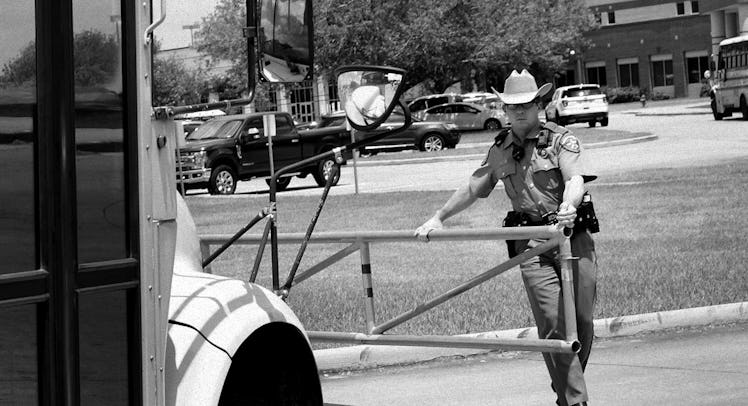All of the Guns in Galveston County Didn’t Stop a School Shooter
The school resource officers on the ground at Santa Fe High School apprehended the school shooter within four minutes. 10 people still died.

The two most recent widely publicized American mass shootings to take place in schools occurred in Santa Fe, Texas and Parkland, Florida, both places where gun culture runs deep. On the outskirts of Galveston, 17-year-old Dimitrios Pagourtzis shot and killed 10 students and staff and injured 13 others in just four minutes. In a tiny suburb of Miami, 17-year-old Nicholas Cruz shot and killed 17 of his former classmates and teachers in just six minutes. Reacting to both slaughters, analysts suggested that the killing might have been prevented had more guns been in the vicinity — in either the hands of teachers or of functional school safety officials.
In fact, both shootings took place in areas where civilian firepower is considerable and armed response had been actively considered. In a sense, they happened to schools that modeled a lot of the policies those who would seek to solve this issue of gun violence with more guns advocate.
In Texas, over one million people have active Concealed Handgun Licenses and over three percent of the population are gun-owners. Based on publicly available data compiled in 2016, in the zip code of Santa Fe High School alone, there are at least 441 people with concealed handgun licenses, and in the surrounding zip codes, there are nearly 8,000. The Galveston area is a concealed carry hotspot. There are only a few more dense concealed carry zones in the United States, many of which are in Florida, which has the most CHL’s of any state in the country. Some 1.7 million Floridians have a license to legally carry a firearm.
People in Santa Fe have guns. People in Parkland have guns.
And people inside both Marjory Douglas Stoneman High School and Santa Fe High School had guns as well. In the wake of the Texas killings, Galveston County Sheriff, Henry Trochesset, confirmed that the two school resource officers on the premises apprehended Pagourtzis within just four minutes. These officers did their jobs with admirable efficiency and commendable bravery — that didn’t happen in Parkland — and Pagourtzis still killed 10 and injured 13 with a shotgun and a revolver.
The two shootings basically model the best and worst case scenarios for school safety officers. The officer at Parkland did nothing right, declining to confront a shooter. The officers at Santa Fe did everything right, moving quickly. In both cases, many children died due to the speed at which the murders took place.
Could the schools have done more to be ready to take down a shooter in seconds instead of minutes? Over 170 school districts in Texas allow staff to carry concealed firearms in their schools, through a plan called the Protection of Texas Children Act. The PTCA allows for one teacher for every 400 students to be trained and armed if they volunteer to undergo the training. The teachers who volunteer have to undergo mental health evaluations and 80 hours of training to qualify. Santa Fe had approved a plan to arm teachers in November of 2017, but had not yet implemented the plan. The district had logistical issues that needed to be worked out and the teachers had not yet completed the considerable training commitment.
This is what implementation of opt-in policies look like. Teachers prioritize teaching over forming a militia, everything takes time, and, in the moment of horror, conditions cannot be controlled. Shooters with functional firearms can kill children in well-run schools.
By all accounts, Santa Fe High School was and is well run. The school’s emergency-preparedness program had received plaudits for responding efficiently to a false report of an active shooter just months before the actual shooting took place. The school was prepared. The officers were in place. The programs to arm teachers were in place. The neighbors were armed. Kids still wound up in the ground.
J.R. Norman, the president of the Galveston school district’s board of trustees, put it best in the wake of the Santa Fe High School shooting. “The way things are, if someone wants to get into a school to create havoc, they can do it,” he told the Texas Tribune. He added that arming teachers and beefing up security programs are ways to limit, but not prevent slaughter.
Offering to simply arm more people to protect children doesn’t appear to be the answer, because the armed people who were supposed to protect the children did not protect them enough. In Texas, arming teachers and officers is not a new policy suggestion. It wouldn’t even require creating new laws. And if the people who are supposed to help our kids admit that arming more teachers is just a strategy of mitigation, not outright safety, then we need a better plan. Perhaps one that could get rid of the problem of guns altogether. We cannot settle on trying to limit the chaos. We need to stop the chaos. If the solution is to continue to arm adults with firearms in perpetuity, then we have been avoiding the truth: that the presence of guns and the dangerous people who wield them, even if they are disarmed within four minutes, can cause legitimate, physical, and fatal harm to children.
This article was originally published on